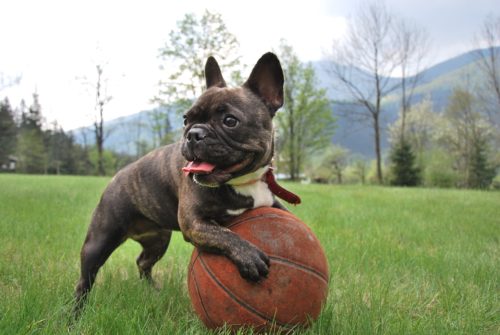Your dog is not acting how he usually does. Maybe he shakes and pants every time you leave the house, or maybe he is turning aggressive towards family friends and visitors. Either way, you know something is going on with your beloved companion.
From the outside, they may seem completely normal. A little odd behavior catches your attention but besides that everything else is fine, right? If you notice your dog is developing different behaviors every time they are triggered by something or whenever you leave the house, this could mean they are suffering from anxiety.
It may surprise you that dogs can become stressed or feel anxious in certain situations just like humans. But think about it, how many times have you seen a dog begin to desperately bark as soon as they lose sight of their owner? Other common signs of anxiety in dogs include trying to escape the yard or destroying the living room furniture as soon as their owners have left the building. It’s a lot more common of an issue than one might think.
Unlike most illnesses, dogs can show signs of anxiety in a variety of ways. There is not a single sign that indicates your dog is suffering from this mental condition, rather it’s a mixture of different signals and behaviors they are giving off in their distress.
In this guide, you will learn everything you need to know about the signs and symptoms of anxiety in dogs. With a little guidance, you will be able to tell if your dog is feeling stressed and learn ways to help them overcome it. By avoiding triggers and training them to react differently, you will be able to reduce their anxiety and exterminate those bad behaviors.
What is Anxiety in Dogs?

Anxiety is defined as the anticipation of potential dangers from unknown sources. In most cases, dogs suffering from anxiety will develop behavioral issues or bodily reactions to a particular stimulus that is causing their panic and anxiety. The most common form of anxiety is separation anxiety in dogs, which can occur when a dog is left alone for any period of time.
These behaviors can be diminished only when a plan of action is in course. You can’t expect the anxiety just to disappear when nothing has been done to cure it. Just like any other health condition, a dog suffering from this kind of problem will need to seek professional help from their veterinarian to identify the underlying cause. From there, your vet will be able to recommend tips on how to avoid these triggers or provide anti-anxiety medication for dogs if their condition is in a severe stage.
How to Tell If Your Dog Has Anxiety
How is it possible to tell if your dog is suffering from anxiety without them being able to communicate that to you verbally? Well actually, it’s quite simple. Dogs are intelligent creatures and are able to express what they are thinking and how they feel through body language and behavior. From there, it is your duty as their owner to be able to depict these cues and figure out what your pup is trying to say.
Consider your dog’s behavior in each particular situation. For example, just because he’s panting does not mean he is feeling stressed right after he just went for a run. However, if he is exhibiting this strange behavior during a loud thunderstorm, this could be giving off a different meaning.
You know your dog better than anyone else. You know when they are relaxed, you know when they are happy, and you even know when they are agitated after seeing another dog across the street. The point is, you should be able to spot any behaviors that are not common for your pup. Once these changes in behaviors arise, pay close attention to what may be triggering this to see if this is what’s causing them stress.
Causes of Anxiety in Dogs
There are lots of reasons your dog may become anxious or stressed, but there are still a few popular triggers that may be the source. Some well-known causes of dog anxiety may include:
- Separation anxiety when their owner leaves the house
- An illness or an injury that causes pain
- Infectious diseases or toxic conditions
- Fear from a terrifying experience
- Certain phobias
As said before, all dogs can develop anxiety from a number of different reasons. Just like with humans, each dog is unique and may have their own concerns or fears that they find in everyday life.
Symptoms of Anxiety in Dogs
Whether big or small, there are a vast array of different symptoms a dog may exhibit if suffering from anxiety. While some of these signs may be hard to separate from regular daily behavioral patterns, it is still important to notice when these changes arise.
Subtle changes in behavior that can be indicative of anxiety may include:
- Seeking comfort or affection
- Excessive licking or chewing
- Hiding or searching for solitude
- Panting and shaking
More profound symptoms that can surface due to anxiety may include:
- Aggressive behaviors
- Attempting to escape
- Overexertion
- High energy
- Excessive barking and howling
- Excretion
- Panic attacks
- Destruction
Separation Anxiety in Dogs
The most common form of anxiety is separation anxiety in dogs, which can occur when a dog is left alone for any period of time. Separation anxiety occurs when a dog or puppy develops a phobia from being left alone. Dogs suffering from this condition may develop behavioral issues and severe stress. Often, dogs who have been adopted from a kennel have either lost a loved one or have been previously mistreated, which has caused separation anxiety to surface later on when they’re older.
It is also important to note that there are two stages of life that dogs commonly develop separation anxiety. Both puppies and older dogs are prone to this condition, so pay extra attention if this factor applies to your pup.
Just like any other forms of anxiety, a dog suffering from separation anxiety will develop destructive behavior, urinate throughout the house, become aggressive, or exhibit odd behavior. If your dog is showing any of these symptoms, notice when they occur. Chances are, your dog may be feeling anxious when they are around specific triggers.
How to Diagnose Anxiety in Dogs

If you feel that your dog may be suffering from anxiety, the best thing you can do for them is to seek professional help. Take them to the veterinarian for a thorough examination and provide your vet with as much information you can about any behavioral changes or other symptoms you may have noticed.
After reviewing their symptoms and their complete medical history, your vet will then be able to form a proper diagnosis. Your vet will first try to narrow down the issue and rule out any other potential health problem that may be causing the symptoms. From there, they will try to pinpoint the actual trigger that is causing the anxiety and advise ways to avoid this trigger from affecting your dog. If the issue is caused by a toxin in your dog’s system (such as lead or any other harmful substance), your vet will then conduct a blood test to analyze their physical health further.
Once the source has been identified, your vet will then be able to devise a proper treatment plan. Now, this may vary greatly depending on the source. If it is just a phobia or fear, they may provide you with specific guidelines and recommendations on how to avoid the trigger from upsetting your dog. If it is something more serious, your vet will create a more tailored treatment plan depending on your dog’s individual needs and requirements.
How to Manage Anxiety in Dogs
Once your dog has been diagnosed with anxiety, you can work on figuring out how to solve this issue and get them back to living a normal, relaxed life. Depending on the severity of the issue, the vet may prescribe medication or come up with a specific treatment plan to make your dog feel more comfortable. Anti-anxiety medication may be prescribed, however, this is usually in the last case scenario.
One suggestion for people who are learning how to calm an anxious dog down is to see if crate training helps their condition. This will vary from each dog, so make sure you know in which state your dog feels the most comfortable. Most cases, when a dog is crated while their owner leaves for an extended period, they feel that this is their “safe zone” and are in a calmer stage than before.
However, this technique does not work for every dog. Some may actually feel the opposite and think they are trapped when they are inside their crate. That’s why it is important to analyze the situation when you are still home and test your pup to see which method works best for them.
If your dog is suffering from separation anxiety, there are several steps you can take to help improve their condition. For starters, never leave them home alone for long periods of time without any human interaction. After all, this is probably the main cause of the anxiety in the first place.
If you are busy working all day and have no one to visit your dog, try taking them to a dog sitter where they can play with other dogs and get plenty of attention while you are away. There are plenty of facilities who specialize in this kind of care who are both reliable and safe for your beloved pet.

When you are home with them, it is critical that you give your dog plenty of attention and affection. Exercise is also an essential factor in this entire equation. Never skip out on their daily walks or play time just because you don’t have time for them. Your daily walks not only satisfy their daily exercise requirements, but it also puts them in a calmer, more happy state of mind.
Desensitization is the most effective method when your dog’s anxiety is brought on by a particular trigger such as fireworks, thunderstorms, or even car rides. This method means that your dog will learn how to reduce their reaction to the trigger or stimulus that is causing their issues. In this particular situation, you would want to overexpose your dog to this trigger and train them to act calmly.
Counter-conditioning can also be used to train your dog to perform a desirable behavior once they have been exposed to their trigger. This works to replace the bad behavior issue with a learned command, such as sitting. If your dog is following your command and behaving in a positive light, you can reward their good behavior with treats or praise to reinforce their behavior.
A common mistake that many pet owners make when aiding their dog in panic or anxiety is to comfort them. While this may seem like the best solution, it is actually doing more harm than you might think. Most dogs will take this action as a reward, and it will continue to encourage their unfavorable behavior. Instead of comforting them, encourage them to act calmly.
If you think your dog is suffering from some form of anxiety, take them to the vet for a thorough examination. As said before, the signs of dog anxiety can be very subtle, so it’s up to you to notice any changes in behavior or common occurrences that are causing panic in your furry companion.
At the end of the day, being there for your dog during this time of distress is the best thing you can do for them. Whether they have separation anxiety or it’s brought on by a different source, find out the leading cause and act accordingly. Your vet is an excellent resource to learn various tips and tricks to manage your dog’s anxiety.
Sources:
- “Extreme Fear and Anxiety in Dogs.” PetMD, Accessed 8 Dec 2017. www.petmd.com/dog/conditions/behavioral/c_dg_fears_phobia_anxiety.
- “How to Know If Your Dog Has Anxiety.” PetCareRx, Accessed 8 Dec 2017. www.petcarerx.com/article/how-to-know-if-your-dog-has-anxiety/702.
- Rodriguez-Cayro, Kyli. “6 Signs Your Dog Has Anxiety.” Bustle, Accessed 8 Dec 2017. www.bustle.com/p/dog-anxiety-symptoms-include-these-6-unexpected-things-8723564.
- Harleman, James. “15 Signs That Your Dog Is Stressed.” Rover, 31 May 2018, Accessed 8 Dec 2017. www.rover.com/blog/stressed-dogs-signs/.
- “Anxiety in Dogs – Symptoms, Causes, Diagnosis, Treatment, Recovery, Management, Cost.” WagWalking, 9 Mar. 2017, Accessed 8 Dec 2017. www.wagwalking.com/condition/anxiety.




